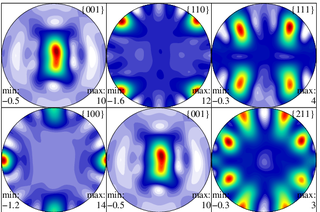
Neutron diffraction or elastic neutron scattering is the application of neutron scattering to the determination of the atomic and/or magnetic structure of a material. A sample to be examined is placed in a beam of thermal or cold neutrons to obtain a diffraction pattern that provides information of the structure of the material. The technique is similar to X-ray diffraction but due to their different scattering properties, neutrons and X-rays provide complementary information: X-Rays are suited for superficial analysis, strong x-rays from synchrotron radiation are suited for shallow depths or thin specimens, while neutrons having high penetration depth are suited for bulk samples.

The High Flux Australian Reactor (HIFAR) was Australia's first nuclear reactor. It was built at the Australian Atomic Energy Commission Research Establishment at Lucas Heights, Sydney. The reactor was in operation between 1958 and 2007, when it was superseded by the Open-pool Australian lightwater reactor, also in Lucas Heights.

The Open-pool Australian lightwater reactor (OPAL) is a 20 megawatt (MW) swimming pool nuclear research reactor. Officially opened in April 2007, it replaced the High Flux Australian Reactor as Australia's only nuclear reactor, and is located at the Australian Nuclear Science and Technology Organisation (ANSTO) Research Establishment in Lucas Heights, New South Wales, a suburb of Sydney. Both OPAL and its predecessor have been commonly known simply as the Lucas Heights reactor.

In physical chemistry and materials science, texture is the distribution of crystallographic orientations of a polycrystalline sample. A sample in which these orientations are fully random is said to have no distinct texture. If the crystallographic orientations are not random, but have some preferred orientation, then the sample has a weak, moderate or strong texture. The degree is dependent on the percentage of crystals having the preferred orientation.

In materials science and solid mechanics, residual stresses are stresses that remain in a solid material after the original cause of the stresses has been removed. Residual stress may be desirable or undesirable. For example, laser peening imparts deep beneficial compressive residual stresses into metal components such as turbine engine fan blades, and it is used in toughened glass to allow for large, thin, crack- and scratch-resistant glass displays on smartphones. However, unintended residual stress in a designed structure may cause it to fail prematurely.
A diffractometer is a measuring instrument for analyzing the structure of a material from the scattering pattern produced when a beam of radiation or particles interacts with it.
The Australian Nuclear Science & Technology Organisation (ANSTO) is Australia's national nuclear organisation and the centre of Australian nuclear expertise. It is a statutory body of the Australian government formed in 1987 to replace the Australian Atomic Energy Commission.

The ISIS Neutron and Muon Source is a pulsed neutron and muon source, established 1984 at the Rutherford Appleton Laboratory of the Science and Technology Facilities Council, on the Harwell Science and Innovation Campus in Oxfordshire, United Kingdom. It uses the techniques of muon spectroscopy and neutron scattering to probe the structure and dynamics of condensed matter on a microscopic scale ranging from the subatomic to the macromolecular.

In materials science, slip is the large displacement of one part of a crystal relative to another part along crystallographic planes and directions. Slip occurs by the passage of dislocations on close/packed planes, which are planes containing the greatest number of atoms per area and in close-packed directions. Close-packed planes are known as slip or glide planes. A slip system describes the set of symmetrically identical slip planes and associated family of slip directions for which dislocation motion can easily occur and lead to plastic deformation. The magnitude and direction of slip are represented by the Burgers vector, b.
High-energy X-rays or HEX-rays are very hard X-rays, with typical energies of 80–1000 keV (1 MeV), about one order of magnitude higher than conventional X-rays used for X-ray crystallography. They are produced at modern synchrotron radiation sources such as the Cornell High Energy Synchrotron Source, SPring-8, and the beamlines ID15 and BM18 at the European Synchrotron Radiation Facility (ESRF). The main benefit is the deep penetration into matter which makes them a probe for thick samples in physics and materials science and permits an in-air sample environment and operation. Scattering angles are small and diffraction directed forward allows for simple detector setups.
The Australian Synchrotron is a 3 GeV national synchrotron radiation facility located in Clayton, in the south-eastern suburbs of Melbourne, Victoria. The facility opened in 2007, and is operated by the Australian Nuclear Science and Technology Organisation.
ENGIN-X is the dedicated materials engineering beamline at the ISIS Neutron and Muon Source in the UK.
The Australian Centre for Neutron Scattering (ACNS), formerly the Bragg Institute, is a landmark neutron and X-ray scattering facility in Australia. It is located at the Australian Nuclear Science and Technology Organisation's (ANSTO) Lucas Heights site, 40 km south-west of Sydney, in New South Wales, Australia.
A materials oscilloscope is a time-resolved synchrotron high-energy X-ray technique to study rapid phase composition and microstructural related changes in a polycrystalline sample. Such device has been developed for in-situ studies of specimens undergoing physical thermo-mechanical simulation.

Philip John Withers is the Regius Professor of Materials in the School of Materials, University of Manchester. and Chief Scientist of the Henry Royce Institute.
Structural chemistry is a part of chemistry and deals with spatial structures of molecules and solids. For structure elucidation a range of different methods is used. One has to distinguish between methods that elucidate solely the connectivity between atoms (constitution) and such that provide precise three dimensional information such as atom coordinates, bond lengths and angles and torsional angles.
Klaus-Dieter Liss, German: Liß, is a German-Australian physicist working in the field of experimental X-ray and neutron scattering and their applications. Liss research is on in-situ and real-time experiments with synchrotron and neutron radiation for the characterization of thermo-mechanical processes in metals; the investigation of phase transformations; the evolution of microstructures; and the kinetics of defects. His experimental achievements are the development of the Materials oscilloscope and the realization of the X-ray photon storage.
Vanessa K. Peterson is a Neutron Instrument Scientist, at the Australian Nuclear Science and Technology Organisation (ANSTO). She established an independent research program at ANSTO which specialised on improving understanding of energy systems and how they work. She manages the Echidna program, a high-resolution powder diffractometer, as well as Wombat - a high-intensity powder diffractometer. Peterson's expertise includes synchtron and laboratory x-ray techniques, as well as neutron powder diffraction, as well as single crystal x-ray diffraction.
Helen Maynard-Casely is an instrument scientist at the Australian Centre for Neutron Scattering at the Australian Nuclear Science and Technology Organisation (ANSTO) in Sydney, Australia. She has won numerous prizes and is an advocate for the participation of women in STEM.
David Dye is a Professor of Metallurgy at Imperial College London. Dye specialises in fatigue and micromechanics of aerospace and nuclear materials, mainly Ni/Co superalloys, titanium, TWIP steel, and Zirconium alloys.






